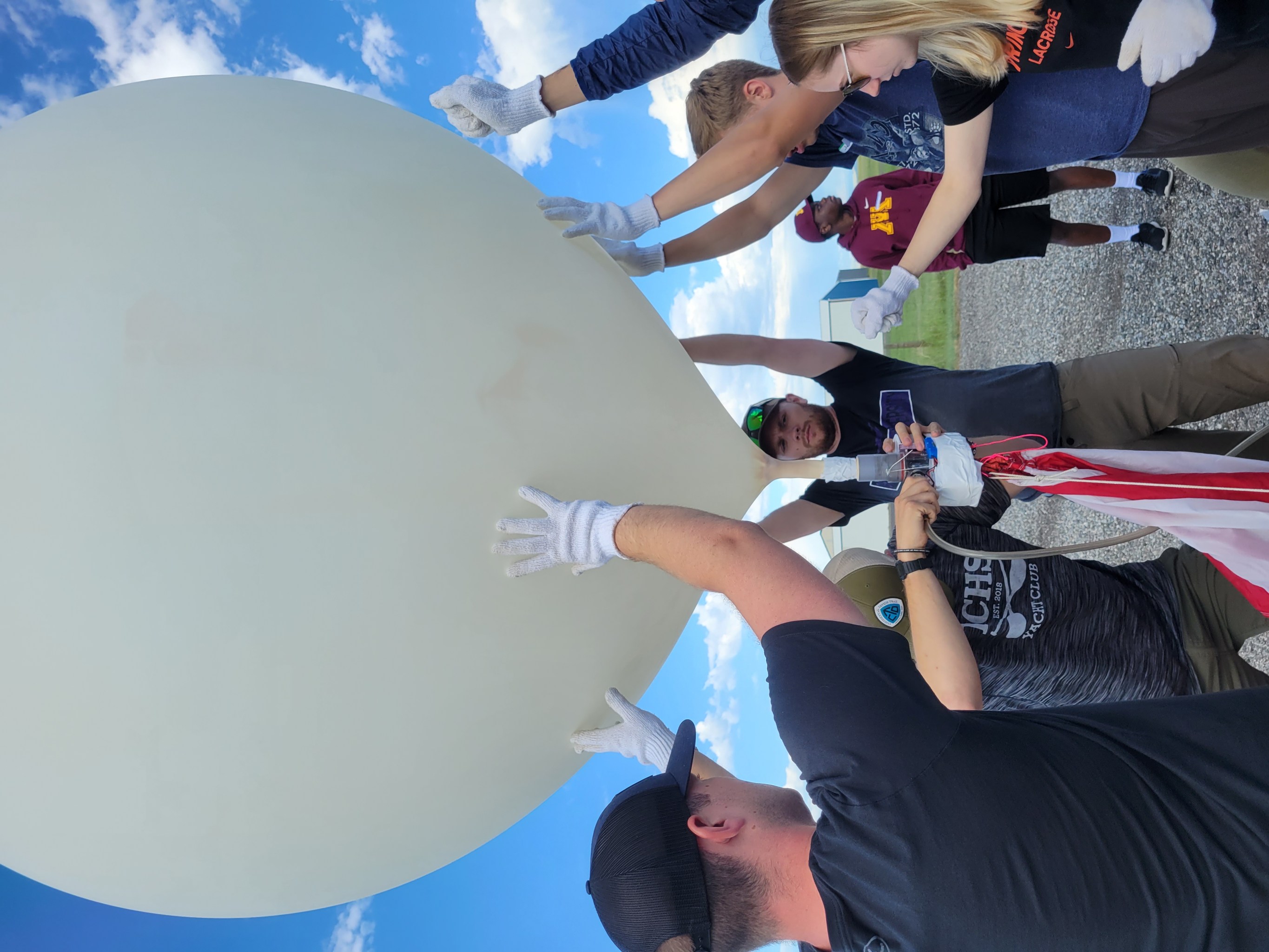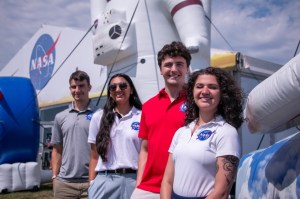Teams of high school and college students from across the country are preparing small experiments to accomplish big science during two upcoming eclipses. Through the Nationwide Eclipse Ballooning Project (NEBP), students will gain real-world STEM experience and contribute valuable scientific and engineering data through their projects, which will be carried by weather balloons into the upper reaches of Earth’s atmosphere.
Portions of North America will experience an annular solar eclipse on Oct. 14, 2023, and a total solar eclipse on April 8, 2024. During an annular solar eclipse, the Moon is at or near its farthest point from Earth, so it appears smaller and does not fully block the Sun, as it does in a total solar eclipse. When these celestial events occur, participating student teams will be in place along the eclipse path to fly their payloads exploring phenomena such as changes in temperatures and gravity waves or testing new technologies.
“The Nationwide Eclipse Ballooning Project is an important educational experience for participants,” said Angela DesJardins, director of the Montana Space Grant Consortium. “But it’s also designed to gather important, solid science.”
NEBP payloads focus on either atmospheric science or engineering. Teams with atmospheric science projects will fly small weather sensors as high as 115,000 feet each hour for 30 hours along the eclipse path. For engineering projects, each team will launch one balloon during each eclipse, floating its 12-pound payload, which includes live streaming cameras, at about 70,000 feet. All teams will participate in both eclipses, and the resulting data will be analyzed and made publicly available.
Participating teams in the atmospheric science category are:
- Alaska: University of Alaska Fairbanks
- Connecticut: University of New Haven
- Idaho: University of Idaho
- Kentucky: University of Kentucky, Lexington; Bluegrass Community and Technical College, Lexington; Texas A&M Corpus Christi
- Louisiana: Delgado Community College, New Orleans; Dillard University, New Orleans; The 1881 Institute (two teams)
- Minnesota: St. Catherine University, St. Paul; St. Cloud State University, St. Cloud; Fond du Lac Tribal and Community College, Cloquet
- Montana: Salish Kootenai College, Pablo
- New Hampshire: Plymouth State University, Plymouth (two teams)
- New Mexico: New Mexico State University, Lac Cruces
- New York: The State University of New York, Oswego
- New York: The State University of New York, Albany
- North Dakota: University of North Dakota, Grand Forks; and Sitting Bull College, Fort Yates
- Oklahoma: Oklahoma State University, Stillwater
- Oklahoma: Gordon Cooper Technology Center, Shawnee; Okmulgee High School, Okmulgee
- Pennsylvania: University of Pittsburgh
- Washington: Central Washington University, Kittitas County
- Wyoming: University of Wyoming, Laramie
Participating teams in the engineering category are:
- Alabama: University of Alabama in Huntsville
- Arkansas: Arkansas State University, Jonesboro
- Arizona: Embry Riddle Aeronautical University, Prescott; Glendale Community College; Phoenix College; and Arizona Near Space Research, Chandler
- Arizona South: Arizona State University, Tempe; University of Arizona, Tucson; Casa Grande Union High School, Casa Grande
- California: University of California San Diego; Miramar College, San Diego; Orange Coast College, Costa Mesa; and Los Angeles City College
- Connecticut: University of Bridgeport
- Connecticut: Hartford University; Tunxis Community College, Farmington
- Delaware: University of Delaware, Newark
- Florida: Florida International University, Miami
- Florida: University of Central Florida, Orlando; University of North Florida, Jacksonville
- Georgia: Mercer University, Macon
- Illinois: South Side Hackerspace, Chicago
- Iowa: Iowa State University, Ames
- Kentucky: Murray State University, Murray; Hopkinsville Community College, Hopkinsville
- Maine: University of Maine, Orono
- Maryland: University of Maryland College Park
- Massachusetts: Olin College, Needham
- Michigan: University of Michigan, Ann Arbor
- Michigan: Eastern Michigan University, Ypsilanti
- Minnesota: University of Minnesota-Twin Cities, Minneapolis
- Missouri: Missouri University of Science and Technology, Rolla
- Montana: Montana State University, Bozeman
- Nebraska: Metropolitan Community College, Omaha; University of Nebraska Omaha; University of Nebraska-Lincoln
- Nevada: University of Nevada Las Vegas and University of Nevada Reno
- New Hampshire: Hanover High School
- Pennsylvania: St. Francis University, Loretto
- Pennsylvania: Gannon University, Erie
- Pennsylvania: Drexel University, Philadelphia; Springside Chestnut Hill Academy, Philadelphia
- Pennsylvania: Penn State University, State College; Lincoln University
- South Dakota: South Dakota School of Mines and Technology, Rapid City; Lakota Tech High School, Pine Ridge; Newcastle High School, Newcastle, Wyoming; Spearfish High School
- Tennessee: Fisk University, Nashville
- Texas: University of Houston
- Virginia: Virginia Tech, Blacksburg
- West Virginia: West Virginia University, Morgantown; Trinity Christian School, Morgantown
- Wyoming: Casper College
- Wyoming: Central Wyoming College, Riverton
Since its inception in 2014, NEBP has supported studies during eclipses in 2017, 2019, and 2020. Led by the Montana Space Grant Consortium, the project is primarily funded through the Science Activation (SciAct) program within NASA’s Science Mission Directorate (SMD) with contributions from the National Space Grant College and Fellowship Project (NASA Space Grant) and support from NASA’s Balloon Program Office, based out of the agency’s Wallops Flight Facility.
NASA’s SMD focuses on advancing our understanding in the areas of Earth science, planetary science, heliophysics, and biological and physical sciences. Through SciAct, SMD provides authentic opportunities for students to engage in these topics and more. NASA Space Grant comprises a national network of higher education institutions and partners. Space Grant’s 52 consortia include one in each U.S. state, the District of Columbia, and the Commonwealth of Puerto Rico.






























